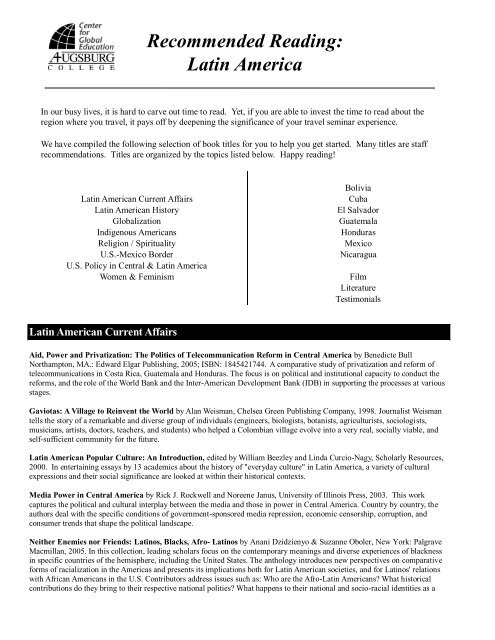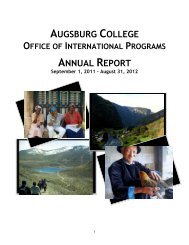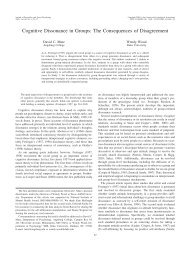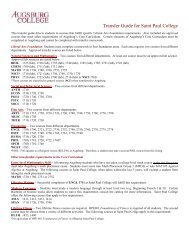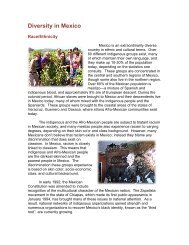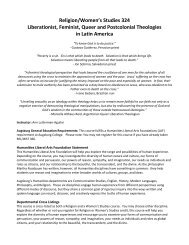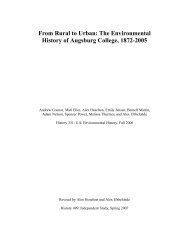Recommended Reading: Latin America
Recommended Reading: Latin America
Recommended Reading: Latin America
You also want an ePaper? Increase the reach of your titles
YUMPU automatically turns print PDFs into web optimized ePapers that Google loves.
<strong>Recommended</strong> <strong>Reading</strong>:<br />
<strong>Latin</strong> <strong>America</strong><br />
In our busy lives, it is hard to carve out time to read. Yet, if you are able to invest the time to read about the<br />
region where you travel, it pays off by deepening the significance of your travel seminar experience.<br />
We have compiled the following selection of book titles for you to help you get started. Many titles are staff<br />
recommendations. Titles are organized by the topics listed below. Happy reading!<br />
<strong>Latin</strong> <strong>America</strong>n Current Affairs<br />
<strong>Latin</strong> <strong>America</strong>n History<br />
Globalization<br />
Indigenous <strong>America</strong>ns<br />
Religion / Spirituality<br />
U.S.-Mexico Border<br />
U.S. Policy in Central & <strong>Latin</strong> <strong>America</strong><br />
Women & Feminism<br />
<strong>Latin</strong> <strong>America</strong>n Current Affairs<br />
Bolivia<br />
Cuba<br />
El Salvador<br />
Guatemala<br />
Honduras<br />
Mexico<br />
Nicaragua<br />
Film<br />
Literature<br />
Testimonials<br />
Aid, Power and Privatization: The Politics of Telecommunication Reform in Central <strong>America</strong> by Benedicte Bull<br />
Northampton, MA.: Edward Elgar Publishing, 2005; ISBN: 1845421744. A comparative study of privatization and reform of<br />
telecommunications in Costa Rica, Guatemala and Honduras. The focus is on political and institutional capacity to conduct the<br />
reforms, and the role of the World Bank and the Inter-<strong>America</strong>n Development Bank (IDB) in supporting the processes at various<br />
stages.<br />
Gaviotas: A Village to Reinvent the World by Alan Weisman, Chelsea Green Publishing Company, 1998. Journalist Weisman<br />
tells the story of a remarkable and diverse group of individuals (engineers, biologists, botanists, agriculturists, sociologists,<br />
musicians, artists, doctors, teachers, and students) who helped a Colombian village evolve into a very real, socially viable, and<br />
self-sufficient community for the future.<br />
<strong>Latin</strong> <strong>America</strong>n Popular Culture: An Introduction, edited by William Beezley and Linda Curcio-Nagy, Scholarly Resources,<br />
2000. In entertaining essays by 13 academics about the history of "everyday culture" in <strong>Latin</strong> <strong>America</strong>, a variety of cultural<br />
expressions and their social significance are looked at within their historical contexts.<br />
Media Power in Central <strong>America</strong> by Rick J. Rockwell and Noreene Janus, University of Illinois Press, 2003. This work<br />
captures the political and cultural interplay between the media and those in power in Central <strong>America</strong>. Country by country, the<br />
authors deal with the specific conditions of government-sponsored media repression, economic censorship, corruption, and<br />
consumer trends that shape the political landscape.<br />
Neither Enemies nor Friends: <strong>Latin</strong>os, Blacks, Afro- <strong>Latin</strong>os by Anani Dzidzienyo & Suzanne Oboler, New York: Palgrave<br />
Macmillan, 2005. In this collection, leading scholars focus on the contemporary meanings and diverse experiences of blackness<br />
in specific countries of the hemisphere, including the United States. The anthology introduces new perspectives on comparative<br />
forms of racialization in the <strong>America</strong>s and presents its implications both for <strong>Latin</strong> <strong>America</strong>n societies, and for <strong>Latin</strong>os' relations<br />
with African <strong>America</strong>ns in the U.S. Contributors address issues such as: Who are the Afro-<strong>Latin</strong> <strong>America</strong>ns? What historical<br />
contributions do they bring to their respective national polities? What happens to their national and socio-racial identities as a
esult of migration to the United States? What is the impact of the growing presence of Afro-<strong>Latin</strong> <strong>America</strong>ns within U.S. <strong>Latin</strong>o<br />
populations, particularly with respect to the continuing dynamics of racialization in the United States today?<br />
People in Nature: Wildlife Conservation in South and Central <strong>America</strong> by Kirsten M. Silvius, Richard E Bodmer, and José<br />
M Fragoso, Colombia University Press, 2004. This book highlights South and Central <strong>America</strong>n approaches to wildlife<br />
conservation and documents both the current state and the historical development of a <strong>Latin</strong> <strong>America</strong>n conservation and<br />
management strategy.<br />
The School of the <strong>America</strong>s: Military Training and Political Violence in the <strong>America</strong>s by Lesley Gill, Duke Univ. Press,<br />
2004. This is a biography of an institution. Written by a teacher of anthropology at <strong>America</strong>n Univ. who goes behind the façade<br />
and presents a comprehensive portrait of the School of the <strong>America</strong>s.<br />
<strong>Latin</strong> <strong>America</strong>n History<br />
Armies Without Nations: Public Violence and State Formation in Central <strong>America</strong>, 1821-1960 by Robert H. Holden,<br />
Oxford University Press, 2004. Public violence is the subject of this research into the histories of Guatemala, El Salvador,<br />
Honduras, Nicaragua, and Costa Rica.<br />
Banana Wars: Power, Production, and History in the <strong>America</strong>s by Steve Striffler & Mark Moberg, Durham: Duke<br />
University Press, 2003. Banana Wars is a history of the <strong>America</strong>s as told through the cultural, political, economic, and<br />
agricultural processes that brought bananas from the forests of <strong>Latin</strong> <strong>America</strong> and the Caribbean to the breakfast tables of the<br />
United States and Europe. The first book to examine such processes in all the western hemisphere regions where bananas are<br />
grown for sale abroad, Banana Wars advances the growing body of scholarship focusing on export commodities from a historical<br />
and social scientific perspective.<br />
Harvest of Empire: A History of <strong>Latin</strong>os in <strong>America</strong> by Juan Gonzalez, Viking Adult, 2000. Gonzalez has a keen<br />
understanding of Hispanic diversity, focusing not just on "Hispanics" as a monolithic category but as a variety of people from<br />
many nations.<br />
The History of Central <strong>America</strong> by Thomas L Pearcy, Westport, Conn: Greenwood Press, 2005. Timeline of historical events -<br />
- 1. Introduction to the seven nations of Central <strong>America</strong> -- 2. Early Central <strong>America</strong> -- 3. From united provinces to independent<br />
states : Costa Rica, El Salvador, Guatemala, Honduras, and Nicaragua -- 4. Panama : from Columbian province to occupied state<br />
-- 5. The United States and Central <strong>America</strong> -- 6. The Cold War I : communism and "freedom fighters" -- 7. Cold War II : Belize,<br />
Costa Rica, and Panama -- 8. Central <strong>America</strong> in the twenty-first century -- Notable people in the history of Central <strong>America</strong> --<br />
Glossary of foreign language words and key concepts -- Central <strong>America</strong>n history : a bibliographic essay.<br />
Human Rights in Cuba, El Salvador, and Nicaragua: A Sociological Perspective on Human Rights Abuse by Mayra<br />
Gómez, Routledge, 2003. This book presents a historical perspective on patterns of human rights abuse in Cuba, El Salvador and<br />
Nicaragua from the late 1960s and 70s to the present day.<br />
<strong>Latin</strong> <strong>America</strong>: A Concise Interpretive History by E. Bradford Burns and Julie A. Charlip, Prentice Hall, 2001. This landmark<br />
volume of <strong>Latin</strong> <strong>America</strong>n history weaves the history of an entire region into a coherent story that emphasizes both common<br />
themes and regional and national specificity.<br />
<strong>Latin</strong> <strong>America</strong> and the United States: A Documentary History, Oxford, 2000. Co-edited collection of 120+ original<br />
documents on US-LA relations, from early 19th century to roughly present.<br />
Mirrors of a Disaster: the Spanish Military Conquest of <strong>America</strong> by Gérard Chaliand, New Brunswick, NJ: Transaction<br />
Publishers, 2005. Gérard Chaliand narrates the major events that followed the Spanish conquest of Mexico and Peru with the<br />
scope and rhythm of an epic poem.<br />
The Open Veins of <strong>Latin</strong> <strong>America</strong>: Five Centuries of the Pillage of a Continent by Eduardo Galeano, Monthly Review Press,<br />
1998, 25 th Anniversary Edition. This classic text organizes the various facets of <strong>Latin</strong> <strong>America</strong>n history according to the patterns<br />
of five centuries of exploitation.<br />
Political Movements and Violence in Central <strong>America</strong> by Charles D Brockett, Cambridge, NY, Cambridge University Press,<br />
2005. This analysis of the confrontation between popular movements and repressive regimes in Central <strong>America</strong>, particularly in<br />
El Salvador and Guatemala, examines urban and rural groups as well as nonviolent social movements and revolutionary<br />
movements over three decades from 1960 on.
Understanding Central <strong>America</strong> : Global Forces, Rebellion, and Change by John A. Booth, Christine J. Wade, and Thomas<br />
W. Walker, Boulder, CO, Westview Press, 2006 (4 th edition). This text explains how domestic and global political and economic<br />
forces shaped rebellion and regime change in Costa Rica, Nicaragua, El Salvador, Guatemala, and Honduras from the 1970s.<br />
Globalization<br />
Globalization and Cross-border Labor Solidarity in the <strong>America</strong>s: The Anti-sweatshop Movement and the Struggle for<br />
Social Justice by Armbruster-Sandoval, Ralph. Publication: New York Taylor & Francis Routledge, 2005. Deals with some of<br />
the obstacles that contemporary anti-sweatshop movements currently face.<br />
Communities in Globalization: The Invisible Mayan Nahual by Juan Pablo Pérez Sáinz and Katherine Andrade-Eekhoff,<br />
Rowman, Littlefield, 2003. This work illustrates the experiences of three Central <strong>America</strong>n communities connected with the<br />
global markets of tourism, handicrafts and manufacturing subcontracts. This book seeks to identify the resources that allow a<br />
community to face globalization while minimizing its risks and maximizing its opportunities.<br />
Confronting Globalization: Economic Integration and Popular Resistance in Mexico by Timothy A. Wise, Hilda Salazar,<br />
and Laura Carlsen, Kumarian Press, Inc., 2003. This book describes the disastrous effects of globalization and trade policies<br />
such as NAFTA, and what some communities in Mexico are doing at the grass-roots political level to defend themselves.<br />
The Coffee Book: Anatomy of an Industry from Crop to the Last Drop by Gregory Dicum and Nina Luttinger, New Press,<br />
1999. Full of facts, figures, cartoons and commentary, this book covers coffee from its first use in Ethiopia in the 6th century AD<br />
to the rise of specialty retailers in the 1990s. The text also considers the exploitation of labor and damage to the environment<br />
that mass cultivation causes, and explores the growing "conscious coffee" market and "fair trade" movement.<br />
The Free Trade Agreement between the United States and Central <strong>America</strong>: Economic and Social Impacts by Raúl<br />
Moreno, EPICA, 2003. This book examines the context of the Free Trade Agreements, the myths and truths about these trade<br />
agreements and the potential social and economic impact of CAFTA in Central <strong>America</strong>.<br />
Mayan Visions: The Quest for Autonomy in an Age of Globalization by June Nash, Routledge, 2001. This book examines<br />
the Chiapas Mayan community of Mexico, and situates the Zapatista rebellion in the context of the centuries-old conflict<br />
between indigenous autonomy and economic conquest.<br />
The Mystery of Capital: Why Capitalism Triumphs in the West and Fails Everywhere Else by Hernando de Soto, Basic<br />
Books, 2000. This book makes a case not for how much wealth was transferred to the West through colonialism, but for how<br />
much wealth was generated in the West because, during the 19 th century, private property laws had developed to the point that<br />
wealth in one area could be the basis for liquid capital to invest in another. De Soto is not afraid to tackle issues of class often<br />
ignored by “Capitalists” of the West.<br />
Rights, Resources, Culture, and Conservation in the Land of the Maya, edited by Betty B. Faust, E.N. Anderson, and John<br />
G. Frazier; foreword by June Nash, Westport, CT, Praeger, 2004. This book is a collection of papers inspired by the work of<br />
Mary Elmendorf, a pioneer in applied anthropology and community development.<br />
Ten Plagues of Globalization by José Víctor Aguilar and Miguel Cavada, EPICA, 2002. This book explains the primary<br />
problems generated by the global economic system, including environmental damage, concentration of wealth, and<br />
unemployment.<br />
Trouble in Paradise: Globalization and Environmental Crises in <strong>Latin</strong> <strong>America</strong> by J. Timmons Roberts and Nikki Demetria<br />
Thanos, Routledge, 2003. This book considers the <strong>Latin</strong> <strong>America</strong>n environmental crisis, presenting an account of its diverse<br />
environmental issues. It frames them in terms of globalization and neo-liberalization processes.<br />
Indigenous <strong>America</strong>ns<br />
Cultural Logics and Global Economies: Maya Identity in Thought and Practice by Edward F. Fischer, University of Texas<br />
Press, 2002. This book examines Mayan cultural identity. Fisher reveals the commonalities and differences, constants and<br />
changes, and challenges and defenses of Mayan people in the modern world.
From Tribal Village to Global Village: Indian Rights and International Relations in <strong>Latin</strong> <strong>America</strong> by Alison Brysk,<br />
Stanford University Press, 2000. From a voice of experience and authority on the subject, she provides a concise picture of the<br />
social movement-it’s impact and drawbacks-and points out some clear pathways to remedy the drawbacks.<br />
Indigenous Movements and Their Critics: Pan-Maya Activism in Guatemala, by Kay B. Warren, Princeton University Press,<br />
1998. This book focuses on the years of Guatemala's peace process (1987-1996) and highlights the crucial role that Mayanist<br />
intellectuals have come to play in charting paths to multicultural democracy in Guatemala and in creating a new middle class.<br />
Las Abejas: pacifist resistance and syncretic identities in a globalizing Chiapas by Marco Tavanti, Routledge, 2003. This<br />
book presents the voices of Las Abejas and of numerous collaborators alongside an innovative theoretical analysis of the<br />
dynamics of identity construction.<br />
Maya Intellectual Renaissance: Identity, Representation and Leadership by Victor Montejo, University of Texas Press:<br />
Austin, 2004. A Jakaltek Maya as well as a trained anthropologist teaching at the University of California, David, Montejo<br />
explores how indigenous leaders can craft a new role for the Maya as partners in solving problems of racism, violence and<br />
development in Guatemala.<br />
Maya Political Science: Time, Astronomy, and the Cosmos by Prudence M Rice, University of Texas Press, 2004. This book<br />
explores the nature of Maya political organization and political geography.<br />
Mesoamerican Voices: Native-Language Writings from Colonial Mexico, Oaxaca, Yucatan, and Guatemala by Matthew<br />
Restall, Lisa Sousa and Kevin Terraciano, Cambridge, NY, Cambridge University Press, 2005. The texts were written from the<br />
sixteenth through the eighteenth centuries by Nahuas from central Mexico, Mixtecs from Oaxaca, Maya from Yucatan, and other<br />
groups from Mexico and Guatemala.<br />
The Miskitu People of Awastara by Philip Adams Dennis, Austin: University of Texas Press, 2004. This is a full-length study<br />
of a coastal Miskitu community, including descriptions of food habits, language, health practices, religious beliefs, and<br />
storytelling. The author contrasts life before and after the war years of the 1980s.<br />
Naming Security - Constructing Identity: 'Mayan-women' in Guatemala on the Eve of 'Peace' by Maria Stern, Manchester<br />
University Press, 2005. By engaging in a careful reading of how ‘Mayan- women‘ ‘speak’ security in relation to the different<br />
contexts that inform their lives, she explores the multiplicity of both identity and security, and questions the main story of<br />
security imbedded in the modern ‘paradox of sovereignty.’<br />
Seeing Indians: A Study of Race, Nation, and Power in El Salvador by Virginia Tilley Albuquerque: University of New<br />
Mexico Press, 2005; ISBN: 0826339255. Introduction: A conqueror's vision -- "There are no Indians in El Salvador" :<br />
indigeneity, the state, and power -- El Salvador's ethnic landscape/s -- "What is an Indian?" -- In the shadow of the Maya --<br />
Remembering Cuscatlán -- From colonial rule to independence -- The Matanza : genocide, ethnocide-- auto-ethnocide? --<br />
Assimilated or erased ? : ethnocide by statistics -- Being mestizo: the twisted logics of Mestizaje -- Celebrating Indians.<br />
Transcending Conquest: Nahua Views of Spanish Colonial Mexico by Stephanie Wood, Norman, OK, University of<br />
Oklahoma Press, 2003. Stephanie Wood uses Nahuatl writings and illustrations to reveal Nahua perspectives on Spanish colonial<br />
occupation of the Western Hemisphere.<br />
Religion / Spirituality<br />
Convictions of the Soul: Religion, Culture, and Agency in the Central <strong>America</strong> Solidarity Movement by Sharon Erickson<br />
Nepstad, Oxford University Press, 2004. This book offers a rich analysis of the experiences of religious leaders and church<br />
members in the liberation struggles in Central <strong>America</strong> in the 1980s.<br />
Globalizing the Sacred: Religion Across the <strong>America</strong>s by Manuel A.Vásquez and Marie F. Marquardt, Rutgers University<br />
Press, 2003. Drawing on case studies in the United States and <strong>Latin</strong> <strong>America</strong>, Vásquez and Marquardt explore the evolving roles<br />
of religion in the <strong>America</strong>s in the face of globalization, transnational migration, the rapid growth of culture industries, and the<br />
crisis of modernity.<br />
Healing a Broken World: Globalization and God by Cynthia Moe-Lobeda, Augsburg Fortress Publishers, 2002. Moe-Lobeda<br />
shows how the advent of globalization places a new horizon on the spiritual quest for religious experience.
Like Grains of Wheat: A Spirituality of Solidarity by Margaret Swedish and Marie Dennis, Orbis Books, 2004. Swedish and<br />
Dennis bring together the stories and experiences of US <strong>America</strong>ns who were engaged in the work of faith-based solidarity in<br />
Central <strong>America</strong> from the late 1970s through the 1990s.<br />
Oscar Romero and the Nonviolent Struggle for Justice by John Dear, Erie, PA: Pax Christi USA, 2004. Fr. John Dear's<br />
revised and redesigned booklet is an introduction to the life and work of Archbishop Oscar Romero. Includes his formation,<br />
conversion, view of the Church, and his devotion to truth. Also includes Scripture passages for meditation and reflection as well<br />
as recommended readings.<br />
Our Cry for Life: Feminist Theology from <strong>Latin</strong> <strong>America</strong> by María Pilar Aquino, Orbis Books, 1993. This book provides an<br />
introduction to feminist theology within the context of <strong>Latin</strong> <strong>America</strong>n liberation theology by Mexico’s most renowned feminist<br />
theologian.<br />
Popol Vuh: The Maya Book of the Dawn of Life translated by Dennis Tedlock, Touchstone, 1996. The Popol Vuh is a record<br />
of stories of Mayan civilization, culture and history that helps to explain Mayan ability to withstand assimilation. This account<br />
of creation is a fundamental text of pre-conquest spirituality in the <strong>America</strong>s.<br />
Protestantism in Guatemala: Living in the New Jerusalem by Virginia Garrard-Burnett, University of Texas Press, 1998. The<br />
central thesis of this book is that the enormous conversion to Protestantism among Guatemalans during the past 40 years can be<br />
traced to the destruction of traditional communities as a result of war, violence, and migration. The adoption of a new religion<br />
provides converts a sense of order and identity.<br />
Quiche Rebelde: Religious Conversion, Politics, and Ethnic Identity in Guatemala by Ricardo Falla and Richard N. Adams,<br />
University of Texas Press, 2001. This work examines what happened when Accion Catolica came into the Guatemalan municipio<br />
of San Antonio Ilotenango, Quiche, to convert its inhabitants. Falla analyzes the movement's origins and why some people<br />
became part of it while others resisted.<br />
Resurgent Voices in <strong>Latin</strong> <strong>America</strong>: Indigenous Peoples, Political Mobilization, and Religious Change, edited by Edward L.<br />
Cleary and Timothy J. Steigenga, New Brunswick, NJ, Rutgers University Press, 2004. This book explores the critical role of<br />
religious beliefs and practices played by indigenous organizations in their struggle to redeem their rights and place in the nations<br />
of <strong>Latin</strong> <strong>America</strong> in which they are encompassed.<br />
Romero: A Life by James R Brockman, Maryknoll, N.Y: Orbis Books, 2005; ISBN: 157075599X. This is an update of<br />
Brockman's The Word Remains: A Life of Oscar Romero ( LJ 12/1/82), his earlier biography of El Salvador's martyred<br />
archbishop. LJ 's reviewer called that book an "insightful account of the situation in Central <strong>America</strong>"; this updated edition has<br />
been released in conjunction with the Paulist Pictures film Romero , starring Raul Julia.<br />
Stubborn Hope: Religion, Politics, and Revolution in Central <strong>America</strong> by Phillip Berryman, Maryknoll, NY, New Press,<br />
1994. A powerful, insightful, and often painfully honest work--a truly essential book for anyone concerned about religion and the<br />
tragic struggles undergone by the people of Central <strong>America</strong>.<br />
Voice of the Voiceless: The Four Pastoral Letters and Other Statements by Oscar Romero, Orbis Books, 1993. This work<br />
includes Romero’s four pastoral letters: The Easter Church; The Church, the Body of Christ in History; The Church and Popular<br />
Political Organizations; The Church’s Mission Amidst the National Crisis. The book also includes his last homily and his letter<br />
to Jimmy Carter.<br />
We Make the Road by Walking by Ann Butwell, Kathy Ogle and Scott Wright, EPICA, 1998. This anthology examines the role<br />
of liberation theology and the church as it relates to the struggles of the poor in postwar and neo-liberal contexts. Topics include<br />
women’s influence on the church, the indigenous face of the church, the role of martyrs as symbols of hope, and solidarity in<br />
areas of violence.<br />
Where is God?: Earthquake, Terrorism, Barbarity, and Hope by Jon Sobrino, Maryknoll, N.Y.: Orbis Books, 2004; ISBN:<br />
1570755663 (pbk.) First reflections after the earthquake -- The earthquake seen from the Christian perspective -- Being honest<br />
toward reality -- The crucified people -- Primordial saintliness -- Terrorism and barbarity: New York and Afghanistan -- Where is<br />
God, and what is God doing in the tragedies? -- Epilogue: redemption and utopia.<br />
Witness to the Kingdom: The Martyrs of El Salvador and the Crucified Peoples by Jon Sobrino, Orbis Books, 2003. This<br />
book contains essays on the role and meaning of martyrdom, including poignant personal memories of Romero and the Jesuit<br />
priests, and reflections on their legacy for the church.
U.S. - Mexico Border<br />
The Children of NAFTA: Labor Wars on the U.S./Mexico Border by David Bacon, Berkeley, CA, University of California<br />
Press, 2004. Normally rare firsthand accounts from Mexican workers make up most of this examination of labor struggles in the<br />
fields and factories along the U.S.-Mexican border in the 10 years since the signing of NAFTA.<br />
Continental Crossroads: Remapping U.S.-Mexico Borderlands History, edited by Samuel Truett and Elliott Young, Duke<br />
University Press, 2004. Drawing on the historiographies and archives of both the U.S. and Mexico, the authors chronicle the<br />
transnational processes that bound both nations together between the early nineteenth century and the 1940s, the formative era of<br />
borderlands history.<br />
Indigenous Mexican Migrants in the United States, edited by Jonathan Fox and Gaspar Rivera-Salgado, Center for U.S.-<br />
Mexican Studies and Center for Comparative Immigration Studies at the University of California, San Diego: 2004. This edited<br />
collection documents changing patterns of indigenous migration between Mexico and the United States and analyzes evidence of<br />
a “binational civil society” that is transforming cultural, social, and political practices across two countries.<br />
On the Rim of Mexico: Encounters of the Rich and Poor by Ramón Eduardo Ruiz, Westview Press, 2000. In this discussion<br />
of the Mexico/U.S. border region, Ruiz contrasts rich and poor, Mexican and <strong>America</strong>n, and illustrates the clashes and<br />
dependencies between the two countries from historical, economic, and sociological perspectives. He addresses the global<br />
economy, NAFTA, environmental concerns, immigration, drug policy, and Mexican identity.<br />
U.S. Policy in Central & <strong>Latin</strong> <strong>America</strong><br />
Bitter Fruit: The Story of the <strong>America</strong>n Coup in Guatemala by Stephen Kinzer and Steven Schlesinger, Anchor Books -<br />
Doubleday, 1999. This book chronicles the overthrow of the democratic government of Guatemalan president Arbenz in 1954 by<br />
the United States. The authors document the role of the CIA and the United Fruit Company in the coup that paved the way for<br />
Guatemala’s civil war.<br />
Confronting the <strong>America</strong>n Dream: Nicaragua Under U.S. Imperial Rule by Michel Gobat, Duke University Press, 2005.<br />
Michel Gobat deftly interweaves political, economic, cultural, and diplomatic history to analyze the reactions of Nicaraguans to<br />
U.S. intervention in their country from the heyday of Manifest Destiny in the 1850s through the U.S. occupation of 1912-1933.<br />
Dark Alliance: The CIA, the Contras and the Crack Cocaine Explosion by Gary Webb, Seven Stories Press, 1999. A simple<br />
phone call concerning an unexceptional pending drug case turned into the uncovering of a massive conspiracy involving the<br />
Nicaraguan Contra Rebels, L.A. and Bay Area crack cocaine dealers, and the Central Intelligence Agency.<br />
The Death of Ben Linder by Joan Kruckewitt, Seven Stories Press, 1999. A biography of Ben Linder, the young engineer who,<br />
while surveying a stream for a hydro plant in rural Nicaragua in 1987, was the first North <strong>America</strong>n killed by the U.S.-backed<br />
Contras. The book incorporates formerly classified CIA documents revealing who killed Linder and why.<br />
The Last Colonial Massacre: <strong>Latin</strong> <strong>America</strong> in the Cold War by Greg Grandin, University of Chicago Press, 2004. This<br />
book explores a hidden history of the Cold War in <strong>Latin</strong> <strong>America</strong>n: one of reactionaries clinging to political power; one of Mayan<br />
Marxists blending native notions of justice with universal ideas of equality; and one of the United States supporting new styles of<br />
state terror throughout the continent.<br />
Not Condemned to Repetition: The United States and Nicaragua by Robert A Pastor, Westview Press, 2002. Robert Pastor<br />
was a major US policymaker in the critical period leading up to and following the Sandinista Revolution of 1979. He shows how<br />
Nicaragua and the U.S. were prisoners of a tragic history and how they finally escaped.<br />
Through a Glass Darkly: The U.S. Holocaust in Central <strong>America</strong> by Thomas R. Melville, Xlibris Corporation, 2005. The<br />
book describes Hennessey's conversion from being an unapologetic patriot from <strong>America</strong>'s heartland to a staunch opponent of<br />
Ronald Reagan's policies in Central <strong>America</strong> - policies that occasionally threatened Hennessey's life.
U.S. intervention and regime change in Nicaragua by Mauricio Solaún, University of Nebraska Press, 2005. Solaún outlines<br />
the role of U.S. foreign policy during the Carter administration and explains how this policy with respect to the Nicaraguan<br />
Revolution of 1979 not only failed but helped impede the institutionalization of democracy there.<br />
When States Kill: <strong>Latin</strong> <strong>America</strong>, the U.S., and Technologies of Terror by Cecilia Menjívar & Néstor Rodriguez, Austin:<br />
University of Texas Press, 2005. Since the early twentieth century, technological transfers from the United States to <strong>Latin</strong><br />
<strong>America</strong>n countries have involved technologies of violence for social control. Organized by region, the essays in this book<br />
address the topic of state-sponsored terrorism in a variety of ways. Most take the perspective that state-directed political violence<br />
is a modern development of a regional political structure in which U.S. political interests weigh heavily. Others acknowledge that<br />
<strong>Latin</strong> <strong>America</strong>n states enthusiastically received U.S. support for their campaigns of terror. A few see local culture and history as<br />
key factors in the implementation of state campaigns of political violence.<br />
Why Nicaragua Vanished : A Story of Reporters and Revolutionaries by Robert S Leiken, Rowman & Littlefield Publishers,<br />
2003. This book takes a closer look at the perceptions that <strong>America</strong>ns develop about foreign countries and the role the press<br />
plays in creating those perceptions.<br />
Women & Feminism<br />
After Revolution: Mapping Gender and Cultural Politics in Neo-liberal Nicaragua, by Florence Babb, University of Texas<br />
Press, 2001. This book explores how Nicaragua's least powerful citizens have fared in the years since the Sandinista revolution,<br />
as neoliberal governments have rolled back the reforms of the Sandinista Revolution and introduced measures to promote the<br />
development of a market-driven economy.<br />
Bananeras: Women Transforming the Banana Unions of <strong>Latin</strong> <strong>America</strong> by Dana Frank, Cambridge, Mass.: South End<br />
Press, 2005. Starting in 1985 with one union in La Lima, Honduras, and expanding domestically through the late 1990s,<br />
experienced activists successfully reached out to younger women with a message of empowerment. In a compelling example of<br />
transnational feminism at work, the bananeras crossed borders to ally with banana workers in five other banana exporting<br />
countries in <strong>Latin</strong> <strong>America</strong>.<br />
Feminism and the Legacy of Revolution: Nicaragua, El Salvador, Chiapas by Karen Kampwirth, Athens: Ohio University<br />
Press, 2004. In many <strong>Latin</strong> <strong>America</strong>n countries, guerrilla struggle and feminism have been linked in surprising ways. Women<br />
were mobilized by the thousands to promote revolutionary agendas that had little to do with increasing gender equality. They<br />
ended up creating a uniquely <strong>Latin</strong> <strong>America</strong>n version of feminism that combined revolutionary goals of economic equality and<br />
social justice with typically feminist aims of equality, nonviolence, and reproductive rights.<br />
From Grandmother to Granddaughter: Salvadoran Women’s Stories by Michael Gorkin, Marta Pineda, and Gloria Leal,<br />
University of California, 2000. These life stories and testimonies of nine Salvadoran women from different generations and<br />
classes present a vivid portrait of life for Salvadoran women today.<br />
From the Revolution to the Maquiladoras: Gender, Labor, and Globalization in Nicaragua by Jennifer Bickham Méndez,<br />
Duke University Press, 2005. Jennifer Bickham Méndez presents a detailed ethnographic account of the Nicaraguan Working and<br />
Unemployed Women's Movement, ìMaría Elena Cuadraî (mec), which emerged as an autonomous organization in 1994.<br />
Gender and Power in Prehispanic Mesoamerica by Rosemary A. Joyce, University of Texas Press, 2000. This book offers a<br />
comprehensive description and analysis of gender and power relations in prehispanic Mesoamerica from the Formative Period<br />
Olmec world (ca. 1500-500 BC) through the Postclassic Maya and Aztec societies of the sixteenth century AD.<br />
Genders in Production: Making Workers in Mexico's Global Factories by Leslie Salzinger, Berkeley, CA, University of<br />
California Press, 2003. Leslie Salzinger careful ethnographic work, personal voice, and sophisticated analysis capture the feel of<br />
life inside the maquiladoras and make a compelling case that transnational production is a gendered process.<br />
Guatemalan Women Speak by Margaret Hooks, EPICA , 1993. Stories of every aspect of women's lives in the context of a 36year<br />
war that had not yet ended.<br />
Liberating Economics : Feminist Perspectives on Families, Work, and Globalization by Drucilla Barker and Susan F.<br />
Feiner, Univ.of Michigan Press, 2004. From the outset the book presents a global, comparative perspective on issues relating<br />
to the social, economic, and political status of women, while emphasizing the heterogeneity of gendered experiences.
Life Out of Death: The Feminine Spirit in El Salvador by Marigold Best and Pamela Hussey, EPICA, 2000. This is a<br />
compilation of interviews with women who lived through the bloody civil war, who share how they are coming to terms with<br />
their memories of war, death squads and disappearances, and how they are using those memories to effect spiritual and physical<br />
healing.<br />
Never Again a World without Us: Voices of Mayan Women in Chiapas, Mexico by Teresa Ortiz, EPICA Task Force, 2001.<br />
Ortiz travels to Chiapas, Mexico, and listens to what indigenous women have to say about their lives in the midst of a hidden<br />
war. She writes of the hopes and struggles of indigenous women in Chiapas, often through their own words.<br />
Radical Women in <strong>Latin</strong> <strong>America</strong>: Left and Right by Victoria Gonzalez and K. Kampworth, Pennsylvania State University<br />
Press, 2001. This work is a collection of essays by scholars from a variety of disciplines, on the political activism of women<br />
from both the left and the right. It challenges stereotypical views of <strong>Latin</strong> <strong>America</strong>n women.<br />
The Revolution Question: Feminisms in El Salvador, Chile, and Cuba by Julie D Shayne, New Brunswick, N.J.: Rutgers<br />
University Press, 2004. Julie Shayne explores the roles of women in revolutionary struggles and the relationship of these<br />
movements to the emergence of feminism. Shayne documents the roles of women in armed and unarmed political activities. She<br />
argues that women contribute to and participate in revolutionary movements in ways quite distinct from men.<br />
Women and Guerrilla Movements: Nicaragua, El Salvador, Chiapas, Cuba by Karen Kampwirth, Pennsylvania State<br />
University Press, 2002. Kampwirth writes here about the women who joined the revolutionary movements in Nicaragua, El<br />
Salvador, and the Mexican state of Chiapas, about how they became guerrillas, and how that experience changed their lives. She<br />
also compares what happened in these countries with Cuba in the 1950s, where few women participated in the guerrilla struggle.<br />
Women in Contemporary Mexican Politics by Victoria Rodríguez, University of Texas Press, 2003. Between 1994 and 2000,<br />
many women surfaced as initiators and leaders in the changing Mexican political community. This book contains chapters on<br />
Mexican women’s political history from 1920 to the present, women in the electoral process, and the continued underrepresentation<br />
of women in the Mexican government.<br />
Writing Women in Central <strong>America</strong>: Gender and the Fictionalization of History by Laura Barbas-Rhoden, Ohio University<br />
Press, 2003. In this book, Barbas-Rhoden evaluates key Central <strong>America</strong>n women novelists and the ways in which each has<br />
rewritten and remembered history and gender in her fiction. She focuses on the effects of revolution and globalization on women<br />
and these writers' ability to represent a complex and changing Central <strong>America</strong>n woman.<br />
Bolivia<br />
A Concise History of Bolivia by Herbert S. Klein, Cambridge, 2003. Surveying Bolivia's economic, social, cultural, and<br />
political evolution from the arrival of early man in the Andes to the present, A History of Bolivia brings the history of this society<br />
up to contemporary times, covering fundamental changes which have occurred since the National Revolution of 1952 and the<br />
return of democracy in 1982.<br />
Dignity and Defiance: Stories from Bolivia’s Challenge to Globalization edited by Jim Shultz and Melissa Crane Draper,<br />
University of California Press, 2008. A powerful, eyewitness account of Bolivia's decade-long rebellion against globalization<br />
imposed from abroad.<br />
Impasse in Bolivia: Neoliberal Hegemony and Popular Resistance by Benjamin Kohl and Linda Farthing, Zed Books, 2006.<br />
This book explores the tensions between markets, democracy, neoliberalism, state restructuring and citizenship. In this regard,<br />
the balance of citizen rights has been shifted away from providing citizens with social rights to privileging the property rights of<br />
private, mostly transnational, firms.<br />
Let Me Speak! Testimony of Domitila, a Woman of the Bolivian Mines by Domitila B. De Chungara with Moema Viezzer,<br />
translated by Victoria Ortiz, The Leo Huberman’s People’s Library, 1978. A true story from the perspective of the indigenous<br />
woman—the wife of a miner in a shanty town of rural Bolivia. It talks about the poor living and working conditions. It also<br />
outlines the author's rise as an activist to fight for the poor working families like her own.<br />
Llamas, Weavings, and Organic Chocolate: Multicultural Grassroots Development in the Andes and Amazon of Bolivia<br />
by Kevin Healy, University of Notre Dame, 2001. This is the story of Bolivian rural development and cultural change in three<br />
parts. The first provides an overview of the history of rural development; the second consists of narratives of nine projects; and<br />
the third analyzes successful outcomes of the projects and their effects.
Struggles of Voice: The Politics of Indigenous Representation in the Andes by José Antonio Lucero, University of Pittsburgh<br />
Press, 2008. Over the last two decades, indigenous populations in <strong>Latin</strong> <strong>America</strong> have achieved a remarkable level of visibility<br />
and political effectiveness, particularly in Ecuador and Bolivia. In Struggles of Voice, José Antonio Lucero examines these two<br />
outstanding examples in order to understand their different patterns of indigenous mobilization and to reformulate the theoretical<br />
model by which we link political representation to social change.<br />
Whispering in the Giant's Ear: A Frontline Chronicle from Bolivia's War on Globalization by William Powers,<br />
Boomsbury, 2006. A personal, inside account by a US worker in Bolivia about the battle for increased economic equality and<br />
environmental conservation worldwide.<br />
Cuba<br />
Cuba: Neither Heaven Nor Hell by María López Vigil, EPICA, 2000. A collection of seven informative essays about<br />
contemporary life in Cuba, all originally published in Envío magazine in Nicaragua. López Vigil and her parents left Cuba in<br />
1961, not because they feared the loss of economic privilege as a result of the revolution, but because they were profoundly<br />
Catholic. In adulthood she returned to her homeland to investigate the effects of "the dazzling, seductive revolution" which she<br />
had foregone. A kind of hopeful objectivity distinguishes her fact-filled essays, for López Vigil possesses both a native's patriotic<br />
optimism and a nonresident's emotional distance.<br />
Cuba: What Everyone Needs to Know by Julia E. Sweig, Oxford University Press, 2009. A nice feature of this book is that it<br />
not only covers Cuban history from the time of the Spanish <strong>America</strong>n War to the Cuban Revolution but is also pretty up to date,<br />
providing an analysis of political issues in Cuba since 2006 when Castro transferred provisional power to his brother.<br />
Learning to Salsa: New Steps in U.S.-Cuba Relations by Vicki Huddleston and Carlos Pascual, Brookings Institute, 2010.<br />
This recently published book about U.S.-Cuba relations was written by two long-term U.S. diplomats; Vicki Huddleston was the<br />
chief U.S. diplomat in Cuba from 1999 to 2002.<br />
El Salvador<br />
Death Foretold: The Jesuit Murders In El Salvador by Martha Doggett and Lawyers Committee for Human Rights,<br />
Georgetown University Press, 1993. Doggett gives a detailed account of the 1989 assassinations of six Jesuits, their housekeeper<br />
and her daughter at the University of Central <strong>America</strong> in San Salvador.<br />
Enrique Alvarez Córdova: Life of a Salvadoran Revolutionary and Gentleman by John Lamperti, Jefferson, N.C.:<br />
McFarland & Company, 2006; ISBN: 0786424737. Centering on El Salvador's political landscape, this biography details the life<br />
of one of the nation's little known revolutionaries. Examined here are the motivations behind Córdova's choice to become a<br />
traitor to his class, El Salvador's political evolution, and the government-condoned assassination of Córdova.<br />
Freedom of Expression in El Salvador: The Struggle for Human Rights and Democracy by Lawrence Michael Ladutke,<br />
McFarland & Co, 2004. This book offers a study of the 1992 Peace Accords, which include the removal of human rights abusers<br />
from the military, the creation of a truth commission and the demilitarization of public security. Ladutke also discusses the<br />
troubling indications that the government is once again reducing the space available for freedom of expression.<br />
Inside El Salvador: The Essential Guide to its Politics, Economy, Society and Environment by Kevin Murray with Tom<br />
Barry, Resource Center Press, 1995. A general overview of the politics, military, economy, society, social organizations,<br />
environment, and foreign influences in El Salvador.<br />
Insurgent Collective Action and Civil War in El Salvador by Elisabeth Jean Wood, Cambridge University Press, 2003. This<br />
book contains interviews from peasants who supported the leftist insurgency in El Salvador and those who did not, as well as<br />
interviews with military commanders from both sides.<br />
Landscapes of Struggle: Politics, Society, and Community in El Salvador edited by Aldo Lauria-Santiago and Leigh Binford,<br />
Pittsburgh, PA, University of Pittsburgh Press, 2004. Landscapes of Struggle offers a broad, interdisciplinary assessment of El
Salvador from the late nineteenth century to the present, focusing on the ways local politics have shaped the development of the<br />
nation.<br />
Oscar Romero and the Communion of the Saints: A Biography, by Scott Wright, with photos by Octavio Duran, Orbis, 2010,<br />
is both a personal witness and a powerful introduction to Romero’s life, told within the larger story of the Salvadoran church and<br />
its many other martyrs, now part of the “communion of saints.” The author lived in El Salvador during the 1980s, working with<br />
refugees and later as part of what was known as the “pastoral accompaniment,” people from the United States and other countries<br />
who came to El Salvador to help shield refugees trying to return to their homes as the civil war was ending.<br />
Oscar Romero: Memories in Mosaic by Maria Lopez Vigil, translated by Kathy Ogle, EPICA, 2000. Interviews with some 200<br />
people who knew Oscar Romero from his childhood to the time of his assassination on March 24, 1980. Their anecdotes allow<br />
the reader an intimate look at Romero and the tumultuous times in which he lived.<br />
Salvadorans in Costa Rica: Displaced Lives by Bridget A.Hayden, University of Arizona Press, 2003. During the political and<br />
economic upheaval that swept El Salvador in the 1980s, as many as 20,000 Salvadorans took refuge in Costa Rica. This book<br />
introduces readers to people from a wide range of class and educational backgrounds who had come to Costa Rica.<br />
Guatemala<br />
Buried Secrets: Truth and Human Rights in Guatemala by Victoria Sanford, Palgrave MacMillian, 2003. This work<br />
chronicles the journey of Maya survivors of the genocide carried out by the Guatemalan army. It traces truth-telling and political<br />
change from isolated Maya villages to national political events.<br />
Guatemala: Never Again, The Official REMHI Report, the Official Report of the Human Rights Office of Archdiocese of<br />
Guatemala, Orbis Books, 1999. REMHI, the Recovery of Historical Memory Project, alternates eyewitness testimony with<br />
conclusions about the origins and impact of the devastating violence in Guatemala from the 1970s to the 1990s. Two days after<br />
the release of this report, Archbishop Gerardi was murdered.<br />
Paradise in Ashes: A Guatemalan Journey of Courage, Terror, and Hope by Beatriz Manz, Berkeley: University of<br />
California Press, 2004; ISBN: 0520240162. Beatriz Manz has written a moving chronicle of Guatemalan villagers who have<br />
endured unspeakable injustice, yet remarkably look to the future with hope. This splendid book is a beautifully written human<br />
story that is framed by the passions and devastating consequences of the cold war. The narrative is a testament to the power of<br />
public anthropology and a must read for those concerned about the marginalized of the South<br />
The Rigoberta Menchú Controversy, edited by Arturo Arias, University of Minnesota Press, 2001. A collection of primary<br />
documents, articles, and essays that debate, from multiple perspectives, the controversy surrounding Guatemalan indigenous<br />
rights leader Rigoberta Menchú. Scholars look at the specifics of the Menchú/David Stoll story, and examine the controversy’s<br />
many implications: for Guatemala, for the world of political activism, and for the disciplines of ethnography and anthropology.<br />
Silence on the Mountain: Stories of Terror, Betrayal, and Forgetting in Guatemala by Daniel Wilkinson, Houghton Mifflen<br />
Company, 2002. This book traces the history of Guatemala's thirty-six-year internal war, focusing on those who were most<br />
affected by Guatemala's half-century of violence, the displaced native people and peasants who slaved on the coffee plantations.<br />
Honduras<br />
Banana cultures: Agriculture, Consumption, and Environmental Change in Honduras and the United States by John<br />
Soluri, Austin: University of Texas Press; ISBN: 0292712561. Soluri multifaceted account of a century of banana production and<br />
consumption adds an important chapter to the history of Honduras, as well as to the larger history of globalization and its effects<br />
on rural peoples, local economies, and biodiversity.<br />
Changing Places: Environment, Development and Social Change in Rural Honduras by William M. Loker, Durham, NC,<br />
Carolina Academic Press, 2004. This book examines the environmental consequences of the construction of a major<br />
hydroelectric dam, the response of local people to dam-induced changes, the ecological effects of changing land use patterns, and<br />
the challenges to local livelihoods posed by globalization.<br />
Enrique's Journey by Sonia Nazario, New York: Random House, 2006; ISBN: 1400062055. Based on the Los Angeles Times<br />
series that won two Pulitzer Prizes, this is a timeless story of families torn apart. When Enrique was five, his mother, too poor to
feed her children, left Honduras to work in the United States. The move allowed her to send money back home so Enrique could<br />
eat better and go to school past the third grade. She promised she would return quickly, but she struggled in <strong>America</strong>....<br />
Honduras, Human Rights Violations Against Lesbian, Gay, Bisexual and Transgender People by Amnesty International,<br />
London: International Secretariat, 2003. Amnesty International believes that the persecution of people for their sexual and/or<br />
gender identity is a violation of their fundamental human rights. LGBT organizations, working to protect people from abuses and<br />
discrimination because of their sexual orientation and/or gender identity should be able to carry out their work without fear or<br />
unjustifiable restrictions.<br />
Striving and Surviving: A Daily Life Analysis of Honduran Transnational Families by Leah Schmalzbauer, New York:<br />
Routledge, 2005; ISBN: 041597593X. Leah Schmalzbauer investigates how transnationalism impacts and structures daily family<br />
life and how transnationalism works as a survival strategy in which families use the difference in living costs between Honduras<br />
and the United States to support household consumption.<br />
Seven Names for the Bellbird: Conservation Geography in Honduras by Mark Bonta, Texas A & M University, 2003. Bonta,<br />
a cultural geographer, argues that contrary to popular belief, Honduran families conserve and value the native wildlife. It is only<br />
when these people become socially marginalized that local environmental destruction occurs.<br />
Mexico<br />
’68 by Paco Ignacio Taibo II, Planeta Pub Corp, 2004. A gripping first-person account, by one of the most distinguished and<br />
prolific Mexican writers of all time, 68 tells of the Tlatelolco massacre of student protestors in Mexico City in the fall of 1968.<br />
Taibo’s work here is to salvage the truth of what happened on the night of October 2 and in the preceding months, drawing on<br />
notes he made at the time, and on memory.<br />
The Annexation of Mexico: from the Aztecs to the IMF by John Ross, Common Courage Press, 1998. Ross, an accomplished<br />
author, correspondent and activist, is most noted for his in-depth account of the 1994 Zapatista uprising. This text tells the story<br />
of 500 years of Mexican history, beginning with the Aztecs and following through to the North <strong>America</strong>n Free Trade Agreement<br />
(NAFTA).<br />
The Community Forests of Mexico: Managing for Sustainable Landscapes edited by David Barton Bray, Leticia Merino-<br />
Pérez and Deborah Barry, Austin: University of Texas Press, 2005. The editors present examples of grassroots forest enterprises<br />
managed by communities as an alternative to deforestation and illegal logging.<br />
Confronting Development: Assessing Mexico's Economic and Social Policy Challenges edited by Kevin J. Middlebrook and<br />
Eduardo Zepeda, Stanford, CA, Stanford University Press, 2003. Because of the importance of the Mexican experience in<br />
continuing debates about options available to developing countries, the twenty-three contributors to this book provide a<br />
comprehensive, interdisciplinary assessment of the principal economic and social policies adopted by Mexico during the 1980s<br />
and 1990s.<br />
The culture of migration in Southern Mexico by Jeffrey H. Cohen, University of Texas Press, 2004. This book explores the<br />
complex constellation of factors that cause rural Oaxacans to migrate, the historical and contemporary patterns of their<br />
migration, the effects of migration on families and communities, and the economic, cultural, and social reasons why many<br />
Oaxacans choose not to migrate.<br />
Homage to Chiapas: The New Indigenous Struggles in Mexico by Bill Weinberg, Verso Books, 2002. Weinberg offers an<br />
introductory tour of Mayan and Mexican history and an overview of NAFTA and then provides a from-the-ground account of the<br />
Zapatista struggle in Chiapas.<br />
The Labyrinth of Solitude, the Other Mexico and Other Essays by Octavio Paz, Grove Press, 1985. This work is a classic<br />
evocation of Mexico’s quest for identity and the cultural differences between Mexico and the United States, written by the 1990<br />
winner of the Nobel Prize for Literature.<br />
Managing Mexico: Economists from Nationalism to Neoliberalism by Sarah Babb, Princeton University Press, 2004. Because<br />
Babb lays out the larger theoretical concerns carefully, she is able to link the Mexican case to broader interpretations, permitting<br />
other scholar to now compare the Mexican case with other developing countries.<br />
The Mexican War by Marc Tyler Nobleman, Minneapolis, MN, Compass Point Books, 2005. Nobleman gives an unbiased<br />
account of the causes, battles, leaders, and the treaty that officially ended the fighting.
Mexico under Fox, edited by Luis Rubio and Susan Kaufman Purcell, Boulder, CO, Lynne Rienner Publishers, 2004. Mexico<br />
made a peaceful transition to democracy when it elected opposition candidate Vicente Fox president in July 2000—an event that<br />
has had a profound impact on the country's political system, its economic and social policy, and its international relationships.<br />
Mexico's Pivotal Democratic Election: Candidates, Voters, and the Presidential Campaign of 2000, edited by Jorge I.<br />
Domínguez and Chappell H. Lawson, Stanford, CA, Stanford University Press, 2004. This book, which traces changes in public<br />
opinion and voter preferences over the course of the race, represents the most comprehensive treatment of campaigning and<br />
voting behavior in an emerging democracy.<br />
Narratives of Greater Mexico: Essays on Chicano Literary History, Genre, and Borders by Héctor Calderón, University<br />
of Texas Press, 2004. Calderon’s readings cover a wide span of time (1892-2001), from the invention of the Spanish<br />
Southwest in the nineteenth century to the América Mexicana that is currently emerging on both sides of the border.<br />
A New Time for Mexico by Carlos Fuentes, University of California Press, 1996. A collection of essays by one of Mexico’s<br />
leading intellectuals. Fuentes discusses the origins and nature of Mexico’s political system and the unforeseen, tumultuous<br />
events that began in 1994 with the Chiapas rebellion.<br />
Refried Elvis: The Rise of the Mexican Counterculture by Eric Zolov, (California, 1999); uses rock music and youth culture<br />
as a lens through which to examine changing middle-class values in the 1950s-60s and the cultural context of the 1968 student<br />
movement.<br />
The War Against Oblivion: Zapatista Chronicles 1994-2000 by John Ross, Common Courage Press, 2000. Ross<br />
dramatizes the experience of the Mayan Zapatistas over the past 6 years, through anecdotes and quotes. This book also<br />
includes a Zapatista timeline, bibliography and an epilogue covering the Mexican presidential elections of July 2000.<br />
Zapata and the Mexican Revolution by John Womack Jr., Vintage Books, 1970. A richly-textured description of the leading<br />
campesino movement from the 1910 Revolution. This work is considered by many historians to be a classic text on the Mexican<br />
revolution.<br />
Zapatista Reader, edited by Tom Hayden, Thunder Mouth Press/Science Books, 2002. In this compilation of essays of authors<br />
that include Nobel Prize winner José Saramago, Octavio Paz, Gabriel García Márquez, the reader takes a journey through the<br />
magical world of culture and politics in Mexico. It demonstrates the relationship that Subcomandante Marcos has had with<br />
leading novelists and journalists and the effect he has had on leading figures in intellectual, political, and literary worlds.<br />
Nicaragua<br />
The Best of What We Are: Reflections on the Nicaragua Revolution by John Brentlinger, University of Massachusetts Press,<br />
1995. Based on his trips to Nicaragua both before and after the defeat of the Sandinistas, Brentlinger interprets the Sandinista<br />
period as a people's struggle for self-realization in work, culture, politics, and community.<br />
Cinema and the Sandinistas: Filmmaking in revolutionary Nicaragua by Jonathan Buchsbaum, University of Texas Press,<br />
2003. This book examines the INCINE film project and assesses its achievements in recovering a Nicaraguan national identity<br />
through the creation of a national cinema.<br />
Learning Democracy: Citizen Engagement and Electoral Choice in Nicaragua, 1990-2001 by Leslie Anderson and<br />
Lawrence C Dodd, University Of Chicago Press, 2005. This book tells the story of how Nicaragua overcame an authoritarian<br />
government and <strong>America</strong>n interventionism by engaging in an electoral revolution that solidified its democratic self-governance.<br />
Nicaragua, Imagining the nation by Luciano Baracco, Algora Publishing, 2005. A history of nationalist politics in Nicaragua<br />
from 19th century liberals to 20th century Sandinistas.<br />
Nicaragua: Living in the Shadow of the Eagle by Thomas W. Walker, Westview Press, 2003. This comprehensive political<br />
history of Nicaragua from pre-independence to the present emphasizes the relationship of Nicaragua to the United States.<br />
Nicaragua: Moon Handbooks by Josh Berman and Randy Wood, Avalon Travel, 2003. This detailed general guide book of<br />
Nicaragua is from the award-winning Moon Handbooks series.<br />
Nicaragua without Illusions: Regime Transition and Structural Adjustment in the 1990s by Thomas Walker, Scholarly<br />
Resources, 1997. This analysis of developments in Nicaragua in the immediate post-Sandinista period examines the aftereffects<br />
of intervention, the transition to democracy, and the impacts of neoliberal economic policies.
Sandinista: Carlos Fonseca and the Nicaraguan Revolution by Matilde Zimmerman, Duke University Press, 2000. The first<br />
English biography of Carlos Fonseca Amador, a leader and key ideological figure in the Sandinista National Liberation Front and<br />
the Nicaraguan Revolution.<br />
Shipwrecked Identities: Navigating race on Nicaragua's Mosquito Coast by Baron L Pineda, New Brunswick, N.J.: Rutgers<br />
University Press, 2006. In this historical ethnography, Baron Pineda traces the history of the port town of Bilwi, now known<br />
officially as Puerto Cabezas, on the Atlantic coast of Nicaragua to explore the development, transformation, and function of<br />
racial categories in this region. From the English colonial period, through the Sandinista conflict of the 1980s, to the aftermath of<br />
the Contra War, Pineda shows how powerful outsiders, as well as Nicaraguans, have made efforts to influence notions about<br />
African and Black identity among the Miskito Indians, Afro-Nicaraguan Creoles, and Mestizos in the region.<br />
The Undermining of the Sandinista Revolution edited by Gary Prevost and Harry Vanden, St. Martin’s Press, 1999. This<br />
collection of essays examines the gains of the Sandinista revolution, the Chamorro and Aleman administrations, international<br />
influences on Nicaragua, and the efforts of grassroots organizations.<br />
Unmasking Class, Gender, and Sexuality in Nicaraguan Festival by Katherine Borland, Tucson: University of Arizona Press,<br />
2006. This book documents the creative innovations of Masaya’s performing artists. The first extended study in English of<br />
Nicaraguan festival arts, Unmasking Class, Gender, and Sexuality in Nicaraguan Festival is an ethnographically and historically<br />
grounded inquiry into three festival enactments during the Somoza, Sandinista, and Neoliberal periods: the carnivalesque<br />
torovenado masquerades, the transvestite Negras marimba dances, and the wagon pilgrimage to Popoyuapa<br />
Uriel Molina and the Sandinista Popular Movement in Nicaragua by John W Murphy & Manuel J Caro, Jefferson, N.C.:<br />
McFarland & Co., 2006; ISBN: 0786424354. This social biography describes the life of Padre Uriel Molina and his role in the<br />
Sandinista Revolution, interweaving history with personal recollections and perspectives. Compiled from primary sources and<br />
extensive interviews with Molina himself, it concentrates on his worldview and the ways in which his perceptions influenced his<br />
stance on various issues.<br />
Film<br />
Even the Rain, directed by Iciar Bollain, 2010. A Spanish film crew helmed by an idealistic director and his cynical producer come<br />
to Bolivia (where the population is 80% Indigenous) to make a revisionist epic about the conquest of <strong>Latin</strong> <strong>America</strong>—on the<br />
cheap. When riots break out in Cochabamba, protesting excessive fees for water, a staple of life-production is interrupted and the<br />
convictions of the crew members are challenged. Even the Rain explores the effects of Spanish imperialism, still resonating 500<br />
years later in the continued struggle of Indigenous people against oppression.<br />
Innocent Voices with Daniel Jimenez Cacho, Lightyear Video, 2007. "Innocent Voices is a raw, powerful portrait of childhood<br />
spent in a war zone. The images are harrowing... And the emotion feels real. Padilla's earnest, natural presence lends an almost<br />
documentary-style realism to Chava's plight." —Associated Press<br />
Strawberry & Chocolate, 1995. This charming Cuban film details the unusual relationship between the flamboyant, educated<br />
Diego and the young, homophobic, pro-Revolution David. Miserable at being dumped by his girlfriend, David at first spurns the<br />
attentions of Diego; however, at the prompting of his Communist roommate, he cultivates an acquaintanceship with Diego in<br />
order to investigate his liberal leanings. Of course, Diego's cultured ways prove fascinating to the younger man and a true<br />
friendship grows. Disputed in its own country, this film was the first Cuban picture to be nominated for best foreign picture at the<br />
Academy Awards. —Jenny Brown for Amazon.com<br />
Red to Violet, produced and directed by Carmen Sarmiento, Video Spots and Associates, in association with Spanish Television.<br />
Princeton, NJ, Films for the Humanities & Sciences, 1997. This program follows the progress of women’s rights and equal<br />
employment from the Contra war through the term of former president Violeta Chamorro. A former Sandinista fighter who lost a<br />
foot laying mines for the Contras wants the government to give her a job; a woman displaced from her job by men returning<br />
from the war objects; another whose daughter was murdered by the Somozist Guard wants justice. Dozens of others tell their<br />
stories, as Chamorro defends her coalition government’s policies toward women against criticism by feminists, who seek a wider<br />
role in political and social decision-making.<br />
Romero with Raul Julia, Vision Video, 1989. Romero is a compelling and deeply moving look at the life of Archbishop Oscar<br />
Romero of El Salvador, who made the ultimate sacrifice in a passionate stand against social injustice and oppression in his<br />
country. This film chronicles the transformation of Romero from an apolitical, complacent priest to a committed leader of the<br />
Salvadoran people.
When the Mountains Tremble, produced by Peter Kinoy; directed by Pamela Yates and Thomas Sigel, New York, NY:<br />
Distributed by New Video, 2004. Though promoted as "the astonishing story" of Nobel Peace Prize winner and Quiche Indian<br />
Rigoberta Menchú, the documentary is actually more the story of the Guatemalan people at large, specifically the struggles of the<br />
poor and peaceful Indian population that came to be labeled "subversives" by a draconian government.<br />
The World is Watching, directed by Peter Raymont and Jim Munro, a political documentary by journalists who traveled to<br />
Nicaragua in 1987, investigating the role of journalists in the US-financed Contra War against Nicaragua’s revolutionary<br />
Sandinista government. Co-Written by: Peter Raymont and Harold Crooks; Co-Produced with Investigative Prod. Inc. 1988.<br />
The World Stopped Watching, directed by Peter Raymont, is a sequel to The World is Watching. Raymont follows some of the<br />
same journalists into Nicaragua to explore what happened after the international media attention faded. Some say Raymont and<br />
his crew are the first international journalists that Nicaraguans have seen since the 1990 elections. Produced by Peter Raymont,<br />
Harold Crooks, and Lindalee Tracey with the National Film Board of Canada. 2003.<br />
Return to El Salvador, 2009. In 1992, U.N. Peace Accords marked the end of a brutal civil war in El Salvador. This film,<br />
narrated by Martin Sheen, is the compelling story of vibrant Salvadoran individuals and communities and the intricate geopolitical<br />
systems that have so profoundly impacted their lives, making this distant war relevant to a current <strong>America</strong>n audience.<br />
Literature<br />
Agent of Empire: William Walker and the Imperial Self in <strong>America</strong>n Literature by Brady Harrison, Athens: University of<br />
Georgia Press, 2004. Before a Central <strong>America</strong>n national army defeated him in 1857, Walker had made himself military<br />
commander and president of Nicaragua, and embarked on a conscious policy of "<strong>America</strong>nization" and "democratization" of that<br />
state's institutions. Expelled, he conspired repeatedly to return to Central <strong>America</strong>, only to die before a Honduran firing squad in<br />
1860. Provocative and stimulating study, of real relevance to those interested in the links between popular culture and foreign<br />
policy.<br />
Bitter Grounds by Sandra Benitez, Picador USA, 1998. This thoughtful and vivid novel chronicles the lives of three<br />
generations of women in war-torn El Salvador.<br />
The Book of Lamentations by Rosario Castellanos, Penguin USA, 1998. A masterpiece of contemporary <strong>Latin</strong> <strong>America</strong>n<br />
fiction, this novel transposes episodes from actual Maya uprisings in Chiapas in 1712 and 1868 to the 1930s. This book, by<br />
Mexico's most important woman novelist of the twentieth century, combines historical events with modern times.<br />
The Certainty of Spring: Poems by a Guatemalan in Exile by Julia Esquivel Anne Woehrle, Ecumenical Program, 1992.<br />
Divided into four thematic sections, the poems focus on political concerns, poverty, solidarity, and faith. The author's roles as a<br />
theologian and human rights activist are apparent throughout her intensely passionate work.<br />
The Death of Artemio Cruz by Carlos Fuentes, Noonday Press, 1962. With a unique narrative style full of satire and irony,<br />
Fuentes writes a haunting voyage into the soul of modern Mexico, as readers follow the life of General Artemio Cruz.<br />
Erased Faces by Graciela Limón, Arte Publico Press, 2001. Against the charred tapestry of the Zapatista guerilla uprising of<br />
January 1994, personal histories intersect. Weaving the theads of Lacandón myth and history with the events culminating in the<br />
guerilla uprising, Limón creates a rich fabric that restores an identity of those rendered invisible, or whose faces were erased, by<br />
years of oppression.<br />
The Girl From Chimel: Tales From the Land of the Maya by Rigoberta Menchu and Dante Liano, Acorn Book Co, 2003.<br />
This collection of tales remembers the Mayan civilization before it was shattered by the horrors of war.<br />
Harvest of Cain by Jack Nelson-Pallmeyer, EPICA, 2001. This novel describes El Salvador as it heads toward civil war,<br />
featuring ambitious CIA agents colliding with peasant farmers.<br />
The Inhabited Woman by Giconda Belli, Warner Books, 1995. A novel about an accomplished, independent woman during the<br />
Sandinista revolution and how she is inhabited by the spirit of an Indian woman from the time of the conquest.<br />
The Jaguar Smile : A Nicaraguan Journey by Salman Rushdie, Picador, 2003. This book paints a picture of the people and the<br />
politics of Nicaragua, bringing to life the palpable human facts of a country in the midst of a revolution.
The Long Night of White Chickens by Francisco Goldman, Grove Press, 1982. A love story and a mystery about two men<br />
searching for answers about the death of a beautiful young woman murdered while running an orphanage in Guatemala.<br />
The Lost Chronicles of Terra Firma by Rosario Aguilar, translated by Edward Hood, White Pine Press, 1997. This historical<br />
novel retells the conquest of Central <strong>America</strong> through the eyes of women, both Spanish and Indigenous.<br />
Mayan Folktales: Folklore from Lake Atitlan, Guatemala, edited and translated by James Sexton, University of New Mexico,<br />
1999. A collection of Mayan folktales. Written in an oral style, these legends narrate origin and creation stories, explain the<br />
natural world, and reinforce cultural beliefs.<br />
A Necklace of Words edited by Marjorie Agosin and Nancy Abraham Hall, White Pine Press, 1997. The book's sections<br />
focus on the history of Mexico, the arrival of the Europeans and the mixing of races, and the rich interior lives of women<br />
confined by the social fabric of their country.<br />
One Day of Life by Manilo Argueta, Vintage International, 1983. This novel depicts a typical day in the life of a Salvadoran<br />
peasant family during the terror and corruption of a civil war.<br />
A Place Where the Sea Remembers by Sandra Benítez, Scribner, 1993. This novel describes how the activities and<br />
happiness of one family trigger a chain of events in their Mexican village. A haunting story of love and anger, hope and tragedy.<br />
Return of the River: The Selected Poems of Roberto Sosa, translated by Joanne Engelbert, Curbstone Press, 2002. This<br />
bilingual collection offers a well-chosen, representative selection from all nine of Sosa’s poetic works.<br />
Reversible Monuments: Contemporary Mexican Poetry, edited by Monica De LA Torre and Michael Wiegers, Copper<br />
Canyon Press, 2002. This huge bilingual volume introduces readers to both lyric and narrative Mexican poets of varying<br />
backgrounds including indigenous poets writing in Zapotec and Mazatec all born after 1950.<br />
The Story of Colors/La Historia de los Colores by Sub-comandante Marcos, Cinco Punto Press, 1999. Written by Mexican<br />
Zapatista rebel spokesperson Subcomandante Marcos, this bilingual folktale is about the origin of colors. Vividly illustrated, the<br />
simple story reminds readers of the importance of all colors and all ways of thinking, and how this diversity is what makes our<br />
world great.<br />
The Tree of Life: Stories of Civil War by Mario Bencastro, Arte Publico, 1997. Twelve beautiful stories chronicle the<br />
Salvadoran civil war from the perspective of the everyday people.<br />
The Underdogs by Mariano Azuela, Signet Classic, 1962. Considered the greatest novel of the revolution, this is the story of<br />
a courageous Indian farmer who almost unwittingly rises to a generalship in Pancho Villa’s rebel army.<br />
The Weight of All Things by Sandra Benitez, Hyperion, 2002. Set in El Salvador during the civil war of the 1980s, Benitez's<br />
third novel (after A Place Where the Sea Remembers and Bitter Grounds) tells the story of a nine-year-old, seamlessly blending<br />
fact with imagination, evoking the trauma of war more vividly than any newspaper account. In this brief narrative, she gives<br />
voice to the silenced.<br />
When I Look in the Mirror and See You: Women, Terror and Resistance by Margaret Randall, Rutgers University Press,<br />
2003. This book tells the story of the chance meeting of Nora Miselem and Maria Suárez Toro, two survivors who had<br />
disappeared in Honduras during the 1980s.<br />
The Years with Laura Díaz by Carlos Fuentes, translated by Alfred MacAdam, Harvest Books, 2001. This novel, based on<br />
conversations between Fuentes and his two grandmothers, uncovers a long-obscured part of Mexican history: the woman's side.<br />
It tells the story of the extraordinary Laura Díaz, a politically committed artist who bears witness to the Revolution and its<br />
aftermath.<br />
Testimonials<br />
Blood on the Border: A Memoir of the Contra War by Roxanne Dunbar Ortiz, Cambridge, MA.: South End; [London :<br />
Compass Academic distributor], 2005. This is a well-written, important contribution to the history of the Sandinista Revolution<br />
and the U.S. Left in the 1980s. Specifically, its unique focus on the role of indigenous people in a wider social revolution is<br />
invaluable. The misunderstandings with the Sadinistatas and manipulation of the Miskitu and other Atlantic Coast Indians by the<br />
U.S./Contras is telling of the present war on Iraq's ethnic conflict.
The Blindfold’s Eyes: My Journey from Torture to Truth by Dianna Ortiz and Patricia Davis, Orbis Books, 2002. An<br />
<strong>America</strong>n nun presents a memoir detailing her torture in Guatemala while working as a missionary, her escape, her campaign to<br />
reveal the truth, her struggle to heal, and her work as a human rights activist and advocate for the victims of torture.<br />
Confessions of an Economic Hit Man by John Perkins, Berrett-Koehler Publishers, 2004. Perkins, a former chief economist at<br />
Boston strategic-consulting firm Chas. T. Main, says he was an "economic hit man" for 10 years, helping U.S. intelligence<br />
agencies and multinationals cajole and blackmail foreign leaders into serving U.S. foreign policy and awarding lucrative<br />
contracts to <strong>America</strong>n business.<br />
The Country Under My Skin: A Memoir of Love and War by Giconda Belli, Knopf, 2002. This memoir from a Nicaraguan<br />
writer details the author’s life from her privileged upbringing to her decision to join the Sandinistas in 1970 to her current life in<br />
California.<br />
Don't Be Afraid, Gringo: A Honduran Woman Speaks from the Heart: the Story of Elvia Alvorado, edited by Medea<br />
Benjamin, Perennial, 1989. The story of a 48-year old grandmother of 11, speaking as a woman, a Honduran Indian peasant, and<br />
a mother.<br />
The Hour of the Furnaces by Renny Golden, Mid-List Press, 2000. This collection of poems and personal histories of martyrs<br />
and peasants in El Salvador and Guatemala comes from those of religious, humanitarian, guerilla backgrounds.<br />
I, Rigoberta Menchú (An Indian Woman in Guatemala) by Rigoberta Menchú, and edited by Elizabeth Burgos-Debray,<br />
Verso, 1984. Menchú, a Nobel Peace Prize winner, writes of a Quiché Indian woman's life, her indigenous community and her<br />
involvement in the social-political realities of her country.<br />
I Was Never Alone: Prison Diary from El Salvador by Nidia Díaz, Ocean Press, 2001 (new ed. to be published in 2004). This<br />
work comprises a moving personal account of survival by Salvadoran guerrilla leader Nidia Díaz, whose case became the focus<br />
of an international human rights campaign.<br />
The Little School: Tales of Disappearance and Survival in Argentina by Alicia Partnoy, Cleis Press, 1986. Alicia Partnoy<br />
was one of Argentina’s 30,000 “disappeared.” She was abducted from her home by secret police and taken to a concentration<br />
camp where she was tortured, and where most of the other prisoners were killed. This book is Partnoy's memoir of her<br />
disappearance and imprisonment.<br />
Our Voices, Our Lives: Stories of Women from Central <strong>America</strong> and the Caribbean by Margaret Randall, Common<br />
Courage Press, 1995. Through the voices of women fighting for social change and the elimination of sexism in Central <strong>America</strong><br />
and the Caribbean, Randall provides insight into the lives of these women, their strengths, and the recognition of their own<br />
power to change their world.<br />
To Be a Revolutionary: An Autobiography by Padre J. Guadelupe Carney, Harper and Row, 1985. This autobiography<br />
chronicles the life of an <strong>America</strong>n-born Catholic priest, missing and presumed dead, who for 20 years was a driving force for<br />
religious, social and political change in Honduras.<br />
When I Look in the Mirror and See You: Women, Terror and Resistance by Margaret Randall, Rutgers University Press,<br />
2003. This book tells the story of the chance meeting of Nora Miselem and Maria Suárez Toro, two survivors who had<br />
disappeared in Honduras during the 1980s.


